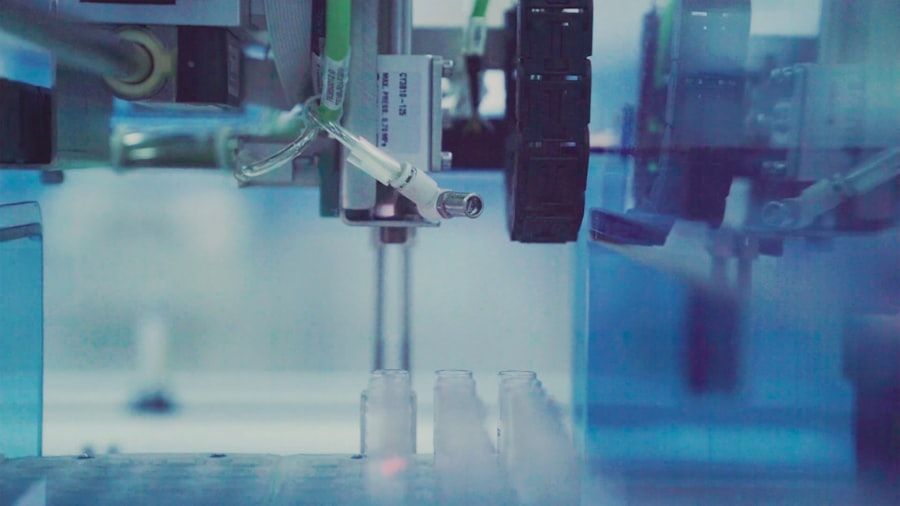The integration of robotics into healthcare represents a transformative shift in how medical services are delivered, enhancing both the efficiency and effectiveness of patient care. As technology continues to evolve, the application of robotic systems in various medical fields has become increasingly prevalent, offering innovative solutions to longstanding challenges. From surgical procedures to rehabilitation therapies, robotics is reshaping the landscape of healthcare, providing tools that augment human capabilities and improve patient outcomes.
This burgeoning field not only promises to streamline operations within healthcare facilities but also aims to enhance the overall patient experience by minimizing discomfort and maximizing precision. The rise of robotics in healthcare is driven by a confluence of factors, including advancements in artificial intelligence, machine learning, and engineering. These technologies have enabled the development of sophisticated robotic systems capable of performing complex tasks with remarkable accuracy.
As healthcare professionals seek to address the growing demands of an aging population and the increasing prevalence of chronic diseases, robotics offers a viable solution to alleviate some of the burdens faced by medical practitioners. By automating routine tasks and assisting in intricate procedures, robots are poised to play a pivotal role in the future of medicine, fostering a new era of healthcare that is more efficient, personalized, and accessible.
Key Takeaways
- Robotics in healthcare is a rapidly growing field that encompasses a wide range of applications, from surgery to rehabilitation and diagnostics.
- Advancements in robotics have revolutionized surgery, leading to improved precision, reduced invasiveness, and faster recovery times for patients.
- In rehabilitation, robotics have shown promise in helping patients regain mobility and function, leading to improved outcomes and quality of life.
- Robotics also play a crucial role in diagnostics and imaging, enabling more accurate and efficient procedures for healthcare professionals.
- Despite the many benefits, challenges and limitations such as cost, training, and ethical considerations need to be carefully addressed in the integration of robotics in healthcare.
Robotics in Surgery: Advancements and Benefits
Surgical robotics has emerged as one of the most significant applications of robotic technology in healthcare, revolutionizing the way surgeries are performed. The introduction of robotic-assisted surgical systems, such as the da Vinci Surgical System, has allowed surgeons to conduct minimally invasive procedures with enhanced precision and control. These systems utilize advanced imaging technology and robotic arms that can maneuver with a level of dexterity that surpasses human capabilities.
As a result, patients benefit from smaller incisions, reduced blood loss, and shorter recovery times, which collectively contribute to improved surgical outcomes and overall patient satisfaction. Moreover, the benefits of robotic surgery extend beyond the operating room. Surgeons who utilize robotic systems often report less fatigue during lengthy procedures due to the ergonomic design of the equipment, which allows for better posture and reduced strain.
This not only enhances the surgeon’s performance but also minimizes the risk of errors that can occur due to physical exhaustion. Additionally, robotic surgery can lead to lower hospital costs associated with shorter patient stays and fewer complications. As hospitals increasingly adopt these technologies, the potential for widespread improvements in surgical care becomes evident, paving the way for a future where robotic assistance is a standard component of surgical practice.
Robotics in Rehabilitation: Improving Patient Outcomes

In the realm of rehabilitation, robotics is making significant strides in enhancing patient recovery processes. Robotic exoskeletons and assistive devices are being developed to aid individuals with mobility impairments, providing them with the support needed to regain their independence. These devices are designed to assist patients in performing therapeutic exercises that promote strength and coordination while reducing the physical burden on therapists.
By incorporating robotics into rehabilitation programs, healthcare providers can offer more personalized treatment plans that cater to the specific needs of each patient, ultimately leading to improved outcomes. Furthermore, robotic rehabilitation systems often incorporate real-time feedback mechanisms that allow patients to monitor their progress and adjust their efforts accordingly. This interactive approach not only motivates patients but also fosters a sense of agency in their recovery journey.
Research has shown that patients who engage with robotic rehabilitation technologies tend to experience faster recovery times and greater overall satisfaction with their treatment. As these technologies continue to evolve, they hold the promise of transforming rehabilitation practices by making them more efficient, engaging, and effective for individuals recovering from injuries or surgeries.
The Role of Robotics in Diagnostics and Imaging
Robotics is also playing an increasingly vital role in diagnostics and imaging within healthcare settings. Advanced robotic systems are being utilized to enhance imaging techniques such as MRI and CT scans, allowing for greater precision in capturing detailed images of internal structures. These systems can automate the positioning of patients and imaging equipment, ensuring optimal alignment and reducing the likelihood of errors that can occur during manual adjustments.
By improving the accuracy of diagnostic imaging, robotics contributes to more reliable assessments and timely interventions for various medical conditions. In addition to enhancing imaging capabilities, robotics is facilitating advancements in diagnostic procedures through automated sample collection and analysis. Robotic systems can perform tasks such as blood draws or biopsies with minimal discomfort to patients while ensuring high levels of accuracy and consistency.
This automation not only streamlines workflows within laboratories but also reduces the potential for human error during sample handling and processing. As a result, healthcare providers can deliver faster diagnoses and initiate treatment plans more promptly, ultimately improving patient care and outcomes.
Challenges and Limitations of Robotics in Healthcare
Despite the numerous advantages that robotics brings to healthcare, several challenges and limitations must be addressed before widespread adoption can occur. One significant concern is the high cost associated with acquiring and maintaining robotic systems. Many healthcare facilities, particularly those in underserved areas or smaller practices, may find it financially prohibitive to invest in these advanced technologies.
This disparity could lead to unequal access to cutting-edge care, exacerbating existing inequalities within the healthcare system. Additionally, there are concerns regarding the training and expertise required for healthcare professionals to effectively operate robotic systems. Surgeons and therapists must undergo extensive training to become proficient in using these technologies, which can be time-consuming and resource-intensive.
Furthermore, there is an ongoing debate about the potential for over-reliance on robotic systems, which may inadvertently diminish the hands-on skills of medical practitioners over time. As healthcare continues to evolve with technological advancements, it is crucial to strike a balance between leveraging robotics for improved care while ensuring that human expertise remains at the forefront of medical practice.
Future Trends and Innovations in Robotics for Healthcare

Collaborative Robots: Enhancing Patient Care and Efficiency
The future of robotics in healthcare holds great promise for innovation, with a focus on enhancing patient care and operational efficiency. A key trend in this area is the development of collaborative robots, or “cobots,” designed to work alongside healthcare professionals rather than replacing them. These robots are intended to assist with tasks such as lifting patients or managing supplies, allowing medical staff to focus on more complex aspects of care while reducing physical strain.
Integrating Technology and Human Skills
This collaborative approach not only improves workflow but also fosters a more integrated environment where technology complements human skills. By working together, healthcare professionals and robots can create a more efficient and effective care system. This integration has the potential to revolutionize the way healthcare is delivered, enabling medical staff to focus on high-value tasks while robots handle more routine or physically demanding tasks.
Artificial Intelligence and Robotics: A Powerful Combination
Another exciting area of exploration is the use of artificial intelligence (AI) in conjunction with robotics to create intelligent systems capable of learning from data and adapting to individual patient needs. For example, AI algorithms could analyze patient responses during rehabilitation sessions and adjust robotic assistance accordingly to optimize recovery outcomes. This powerful combination of AI and robotics holds immense potential for enhancing patient care and improving health outcomes.
Remote Robotic Surgery and Telemedicine
Advancements in telemedicine may also lead to remote robotic surgery capabilities, enabling specialists to perform procedures from afar while maintaining high levels of precision. As these trends continue to develop, they hold immense potential for reshaping healthcare delivery models and enhancing patient experiences across various settings.
Ethical and Legal Implications of Robotics in Healthcare
As robotics becomes increasingly integrated into healthcare practices, ethical and legal implications must be carefully considered. One primary concern revolves around patient privacy and data security. The use of robotic systems often involves collecting sensitive health information that must be protected from unauthorized access or breaches.
Healthcare providers must establish robust protocols to ensure that patient data remains confidential while still allowing for necessary data sharing among medical teams for optimal care. Moreover, there are ethical questions surrounding accountability when robotic systems are involved in patient care. In instances where a robotic device malfunctions or an error occurs during a procedure, determining liability can be complex.
Should responsibility lie with the manufacturer, the healthcare provider operating the system, or both? Establishing clear guidelines regarding accountability will be essential as robotics continue to play a more prominent role in healthcare settings. As we navigate these challenges, it is imperative that stakeholders engage in ongoing discussions about ethical standards and legal frameworks that govern the use of robotics in medicine, ensuring that technological advancements align with the fundamental principles of patient care and safety.
In exploring the advancements in technology and their impact on various sectors, it’s fascinating to see how innovations extend beyond just healthcare. A related exploration can be found in the article How Smartwatches Are Revolutionizing the Workplace. This piece delves into the integration of smartwatches into the corporate environment, enhancing productivity, communication, and employee wellness. Similar to how robotics is transforming healthcare by improving efficiency and outcomes in surgery and rehabilitation, smartwatches are leveraging technology to streamline operations and foster a healthier workplace. Both articles highlight the pivotal role of technology in not only enhancing professional practices but also in promoting well-being across different settings.
FAQs
What is robotics in healthcare?
Robotics in healthcare refers to the use of robotic technology to assist in various medical tasks, such as surgery, rehabilitation, and patient care. These robots are designed to perform precise and complex movements, as well as to provide support and assistance to healthcare professionals.
How is robotics transforming surgery in healthcare?
Robotic surgery systems, such as the da Vinci Surgical System, allow surgeons to perform minimally invasive procedures with enhanced precision and control. This can result in smaller incisions, less pain, and faster recovery times for patients.
What role do robots play in rehabilitation in healthcare?
Robotic rehabilitation devices, such as exoskeletons and robotic arms, are used to assist patients in regaining mobility and strength after injury or illness. These devices can provide targeted support and assistance to help patients with their physical therapy exercises.
What are the benefits of using robotics in healthcare?
The use of robotics in healthcare can lead to improved surgical outcomes, reduced recovery times, and enhanced patient care. Robots can also help healthcare professionals by performing repetitive tasks, allowing them to focus on more complex aspects of patient care.
Are there any limitations or challenges in the use of robotics in healthcare?
Some challenges in the use of robotics in healthcare include the high cost of robotic systems, the need for specialized training for healthcare professionals, and concerns about patient safety and privacy. Additionally, there may be limitations in the capabilities of current robotic technology.

